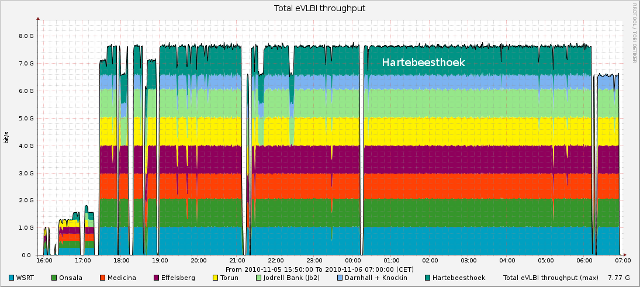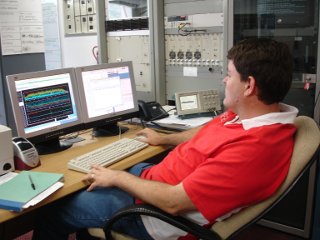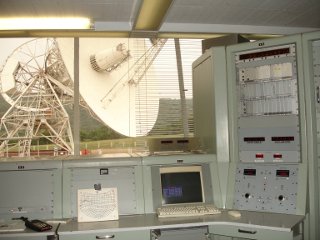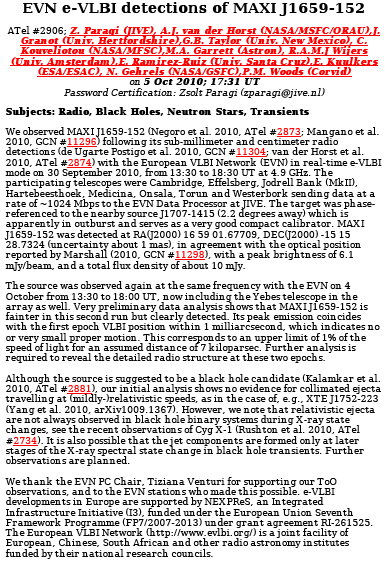
HartRAO Home >
news >
First Wide-band e-VLBI's linking Africa with Europe and with
Australia 2010/11/05 - 2010/11/24
First Wide-band e-VLBI's linking Africa with Europe and with
Australia 2010/11/05 - 2010/11/24
A major role of the 26m radio telescope at the Hartebeesthoek Radio
Astronomy Observatory (HartRAO) is to participate in global networks of
radio telescopes in order to make images of astronomical radio sources with
high angular resolution, through the technique of Very Long Baseline
Interferometry (VLBI). This is normally done by recording the signal
received at each telescope onto computer disks and then airfreighting these
to the data processing system, known as a correlator, where the signals are
combined to provide the data product from which the image is produced.
The advent of wide bandwidth fibre-optic connections between continents has
enabled this to move to the next level, e-VLBI, in which the telescopes are
connected in real time through the internet to the correlator. The ability
to transmit wide bandwidth data to the correlator is very important, as the
sensitivity of the observations increases with increasing bandwidth.
e-VLBI with the HartRAO 26m telescope restarted after 2010 July following the
return to service of the telescope after a main bearing that failed in 2008
October had been replaced.
HartRAO is an associate member of the European VLBI Network (EVN). On 2010
September 30, the first Target of Opportunity (ToO) e-VLBI was carried out
with the HartRAO 26m telescope working with the other radio telescopes of
the EVN. The data from all participating telescopes was transmitted to the
correlator at the Joint Institute for VLBI in Europe (JIVE), at Dwingeloo in
the Netherlands. HartRAO was able to transmit data at 896 Mbps. This may
be contrasted with the maximum bandwidth of 64 Mbps achieved in the first
demonstration e-VLBI's at HartRAO in 2008. In this experiment on September
30, radio emission was detected from a Black Hole candidate in the Milky Way
named MAXI-J1659-152. The results were published in Astronomers Telegram
2906 by the experiment's Principal Investigator Zsolt Paragi and co-workers
on October 5.
On 2010 November 05, courtesy of data rerouting by TENET, the maximum
possible data capture rate from the current recording system of 1024 Mbps
was achieved in another Target of Opportunity e-VLBI on the Crab pulsar
- the rapidly spinning collapsed remnant of an exploded star.
The first ever e-VLBI between Africa and Australia was conducted on 2010
November 24 by the HartRAO 26m telescope working with the 64m Parkes radio
telescope amongst others. This achieved a data transfer rate to the
correlator in Australia of 512 Mbps, the rate being set to match the
Australian processing capability. After successful initial test
observations of bright quasar PKS1921-293 (a distant galaxy emitting radio
waves from jets emerging from around a supermassive Black Hole) used to
calibrate the system, the experiment was switched in real-time to
investigate the sizes of various other southern quasars.
Major impacts of these technical breakthroughs include:
-
The ability to do e-VLBI to the maximum capability of the recording system
means that the time-delay and expense of recording data on disk packs and
airfreighting those to correlators on other continents is removed.
-
Rapid response, real-time e-VLBI on astronomical targets of opportunity is
now possible with HartRAO in South Africa joining the global e-VLBI
networks, permitting new science to be done that was not possible
previously.
-
Strengthening South Africa's position in the global radio astronomy
community.
-
Demonstration of a key technical capability for South Africa in the context
of the future of the international Square Kilometre Array radio telescope
project, and the potential for locating the SKA in Africa.
-
Expanding the potential for training new generations of astronomers.
At HartRAO, VLBI Operations Manager Jonathan Quick has been instrumental
in setting up the radio telescope systems to successfully carry out these
e-VLBI's.
The capability for transmitting wide bandwidth data to other continents is a
result of the actions by the Department of Science and Technology (DST),
through the CSIR's Meraka Institute, in providing the high-speed South
African Research Network (SANReN) infrastructure within the country. The
Tertiary Education Network (TENET) is the operator of SANReN that provides
national and international connectivity to all universities and research
councils via the SEACOM undersea cable and also provides comprehensive
interconnections in London to other research and education networks and the
Internet generally worldwide. At TENET, Duncan Martin and Andrew Alston
have been key facilitators of this process. This worldwide connectivity is
provided through the UbuntuNet Alliance, which is the regional research and
education network for eastern and southern Africa, of which TENET is a
founding member.
International partners were the European VLBI Network (EVN), the Joint
Institute for VLBI in Europe (JIVE), and the Australian CSIRO's Astronomy
and Space Science Division.

Left click on image for large version.
Data rates into the JIVE correlator in Dwingeloo, Holland during the first
maximum rate (1024 Mbps) e-VLBI with Europe, 2010 November 05. Data
received from HartRAO is represented by the dark green band at the top.
Total maximum incoming data rate to JIVE was 7.77 Gbps.

Left click on image for large version.
Jonathan Quick monitors progress in the HartRAO control room during the
first e-VLBI with Australia, 2010 November 24. The graphs on the screen in
front of him show the excellent signal correlation between the 26m HartRAO
telescope in South Africa and the 64m Parkes telescope in Australia.

Left click on image for large version.
The HartRAO 26m telescope, pointing low in the south east, as seen through
the control room windows during the first e-VLBI with Australia on 2010
November 24.

Left click on image for large version.
Astronomer's Telegram 2906 reports the success of the e-VLBI of 2010
September 30 in detecting the radio emission from Black Hole candidate MAXI
J1659-152.


